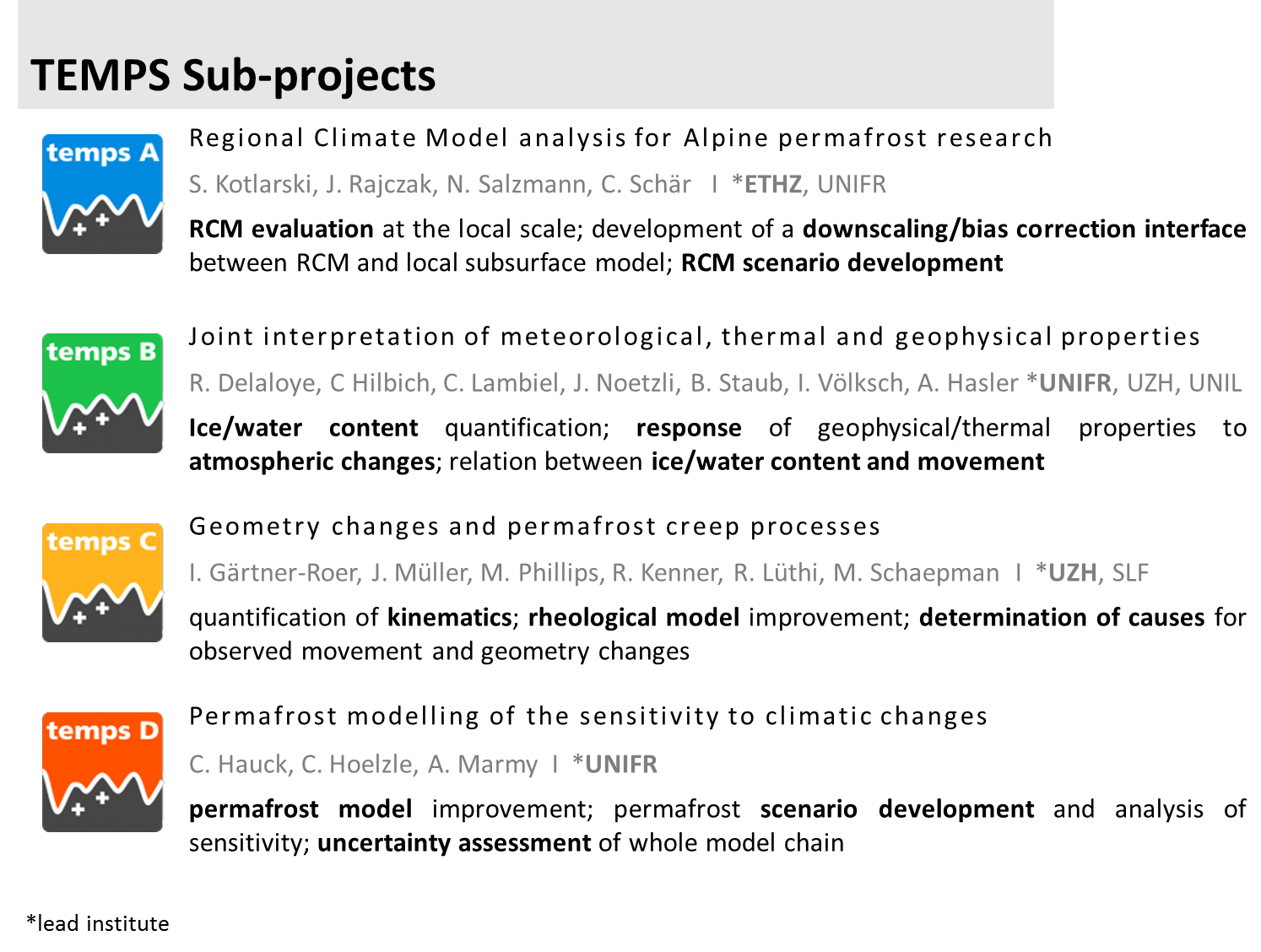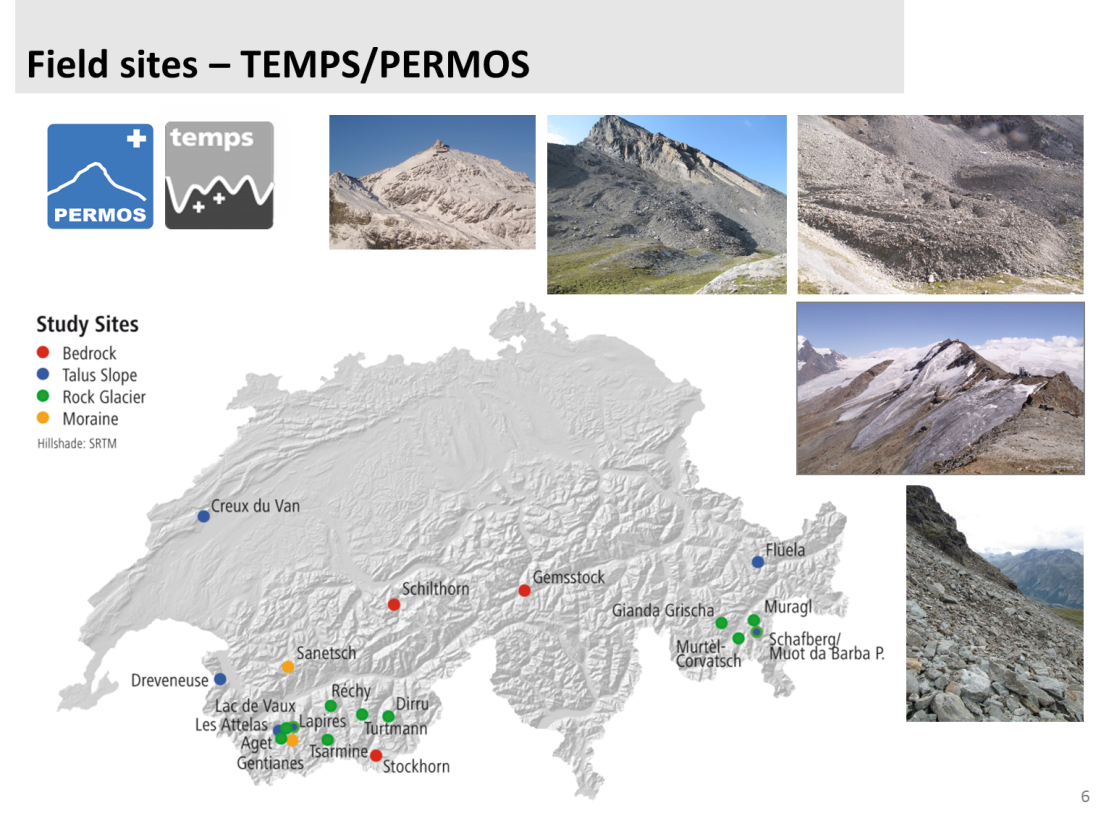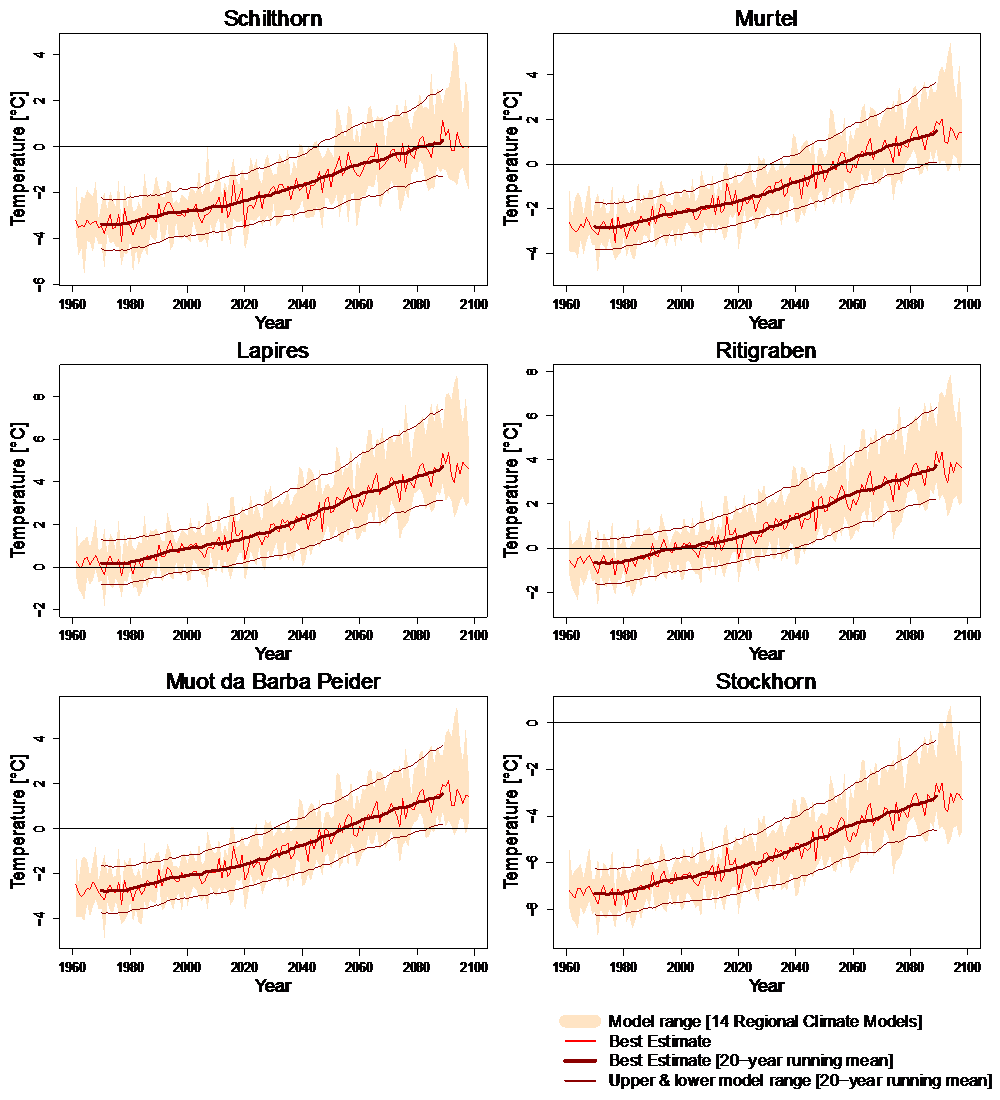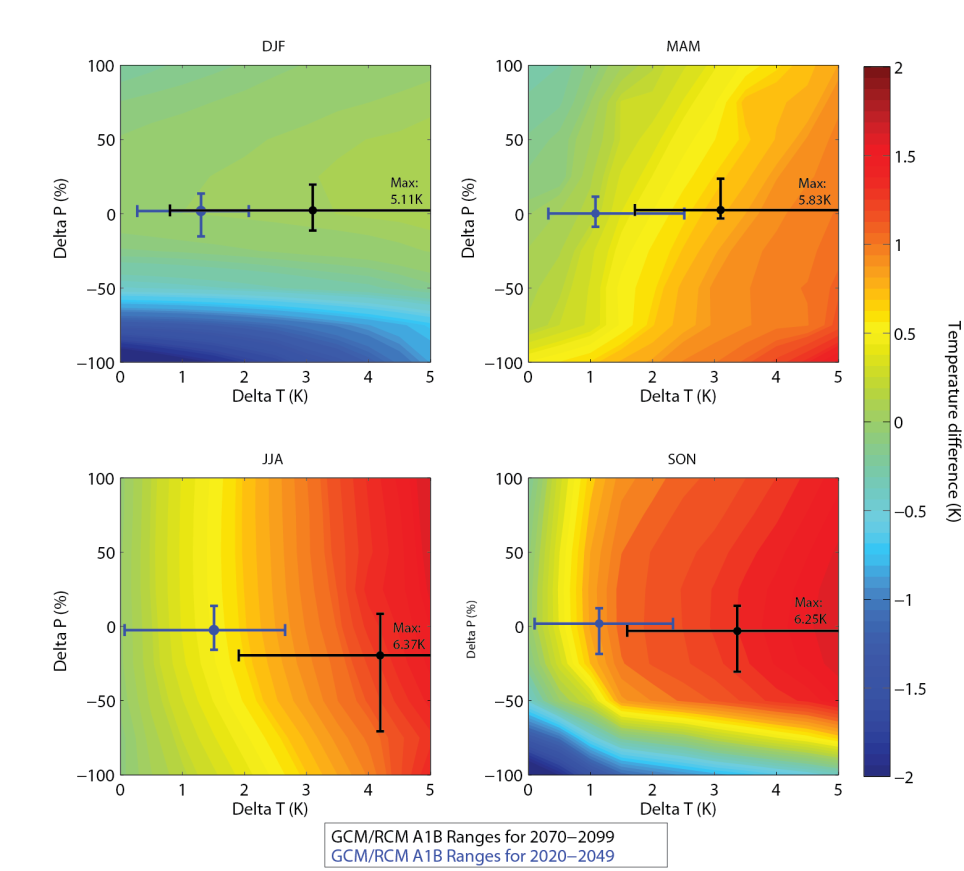The evolution of mountain permafrost in Switzerland (TEMPS)
Permafrost, defined as lithospheric material whose temperature remains below 0 °C for two or more consecutive years, occurs in many high-mountain regions of the European Alps. In the context of anticipated climatic changes, permafrost degradation and associated ground deformation and instabilities could occur. To evaluate the sensitivity of mountain permafrost to climatic changes and to assess its future evolution, not only climatic variables such as air temperature, radiation and timing and duration of snow cover have to be considered, but also subsurface characteristics such as ground temperature, ice content, porosity or hydraulic properties.
Permafrost monitoring in the Swiss Alps started only 1-2 decades ago, but currently comprises a large set of meteorological, geophysical, kinematic and ground thermal parameters at a large variety of field sites, e.g. within the national permafrost monitoring network PERMOS. The project TEMPS analysed and integrated these high-mountain observations with model simulations using a dynamic process-oriented permafrost model. In combination with results from Regional Climate Model simulations, TEMPS created plausible evolution scenarios of mountain permafrost at specific sites and investigated the interactions between atmosphere and permafrost focusing on the evolution of ground temperature, ice content and related degradation and creep processes.
The overall objective of the SNF-Sinergia project TEMPS is to improve the understanding of the vulnerability of mountain permafrost regions to climate changes and assess the potential impact at different field sites in the Swiss Alps. The project includes collaborating scientists from a variety of different fields, such as atmospheric and cryospheric sciences, geomorphology, geophysics, geography and remote sensing.
Research aims:
(1) Determine the influence of the material composition (air, ice and liquid water content, porosity) on ther-mal and kinematic processes and phenomena (e.g. conduction, advection, convection, phase changes, creep, deformation, instability)
(2) Identify the relative importance of site-specific, landform-specific and regional responses to climate forcing
(3) Analyse the future evolution of permafrost in the Swiss Alps
-
Illustrations
Study area:
Site-scale climate scenarios of mean annual air temperature at 2 m above ground (MAAT) for six permafrost monitoring sites.
The results are based on the developed scenarios using the two-step procedure of Rajczyk et al. (2015) and are based on 14 ENSEMBLES regional climate models assuming an A1B greenhouse gas emission scenario (taken from Marmy et al. 2015).
Difference in simulated (with the soil model COUP) mean annual soil temperature at 5m depth at the end of the century between a seasonal anomaly rum (i.e. the application of a ?Temperature and a ?Precipitation during a given season: DJF, MAM, JJA and SON, for every year) compared to a reference run for the permafrost site Schilthorn.
The bars indicate the range of 10 individual GCM/RCM model chains for A1B scenario for the period 2020-2049 (blue) and for the period 2070-2099 (black) (taken from Marmy et al. 2013).
-
Publications
- Hauck, C. (2013): New concepts in geophysical surveying and data interpretation for permafrost terrain. Permafrost and Periglac. Process. 24, 131–137, doi: 10.1002/ppp.1774.
- Kenner R., Bühler Y., Delaloye R., Ginzler C., Phillips M. (2013). Monitoring of high alpine mass movements combining laser scanning with digital airborne photogrammetry. Geomorphology. 10/2013; DOI: 10.1016/j.geomorph.2013.10.020
- Marmy A, Salzmann N, Scherler M, Hauck C (2013): Permafrost model sensitivity to seasonal climatic changes and extreme events in mountainous regions, Environ. Res. Lett. 8 035048 doi:10.1088/1748-9326/8/3/035048
- Marmy, A., Rajczak, J., Delaloye, R., Hilbich, C., Hoelzle, M., Kotlarski, S., Lambiel, C., Noetzli, J., Phillips, M., Salzmann, N., Staub, B., and Hauck, C. (2015): Semi-automated calibration method for modelling of mountain permafrost evolution in Switzerland, The Cryosphere Discuss., 9, 4787-4843, doi:10.5194/tcd-9-4787-2015.
- Rajczak, J., Kotlarski, S., Salzmann, N., Schär, C. 2015: Robust climate scenarios for sites with sparse observations: a two-step bias correction approach. Int. J. Climatology. doi: 10.1002/joc.4417.
- Scherler, M., Schneider, S., Hoelzle, M. and Hauck, C. 2014. A two-sided approach to estimate heat transfer processes within the active layer of the Murtèl–Corvatsch rock glacier. Earth Surf. Dynam., 2, 141–154.
- Staub, B. & Delaloye, R. (in press): Using Near-Surface Ground Temperature Data to Derive Snow Insulation and Melt Indices for Mountain Permafrost Applications. Permafrost and Periglacial Processes.
- Staub, B., Marmy, A., Hauck, C., Hilbich, C., and Delaloye, R. (2015): Ground temperature variations in a talus slope influenced by permafrost: a comparison of field observations and model simulations, Geogr. Helv., 70, 45-62, doi:10.5194/gh-70-45-2015.
Duration: 2011-2015
Funded by: Swiss National Science Foundation (SNF)
Collaborators: Prof. Christian Hauck, R. Delaloye, A. Hasler, M. Hoelzle, C. Hilbich, A. Marmy, N. Salzmann, B. Staub, (Univ. Fribourg), I. Gärtner-Roer, J. Müller, J. Noetzli, M. Schaepman, I. Völksch (Univ. Zurich), S. Kotlarski, J. Rajczak, C. Schär (IAC, ETH Zurich), C. Lambiel (Univ. Lausanne), R. Kenner, R. Lüthi, M. Phillips (WSL Institute for Snow and Avalanche Research SLF, Davos)
Contact
Prof. Christian Hauck
Geography
Department of Geosciences
University of Fribourg
Chemin du Musée 4
CH–1700 Fribourg
+41 26 300 90 21




